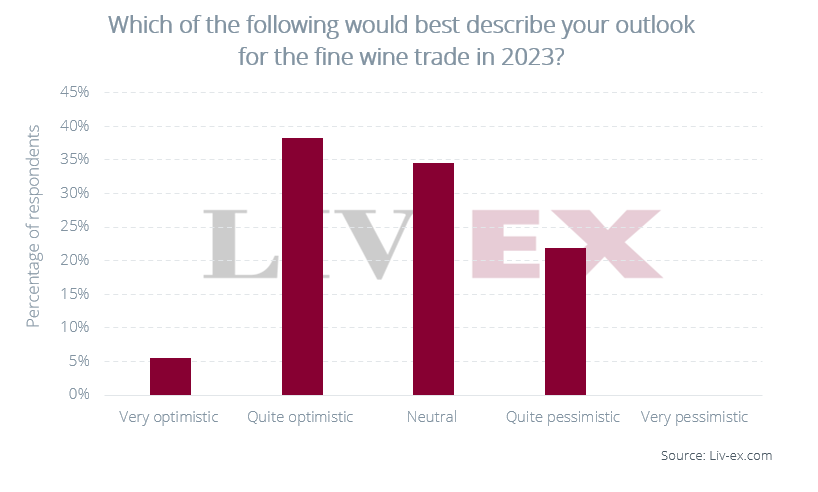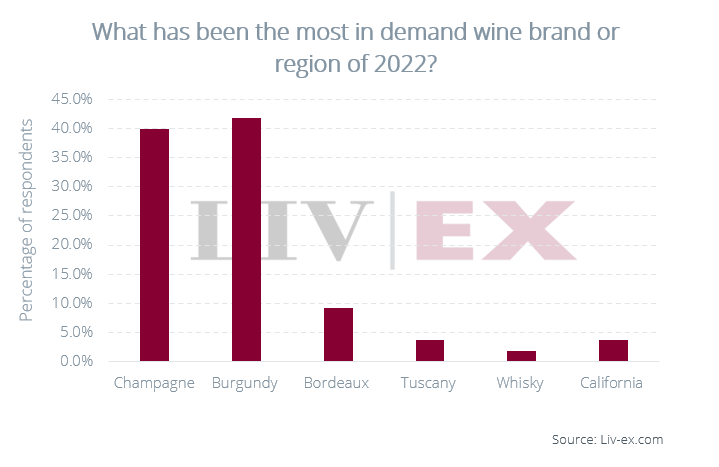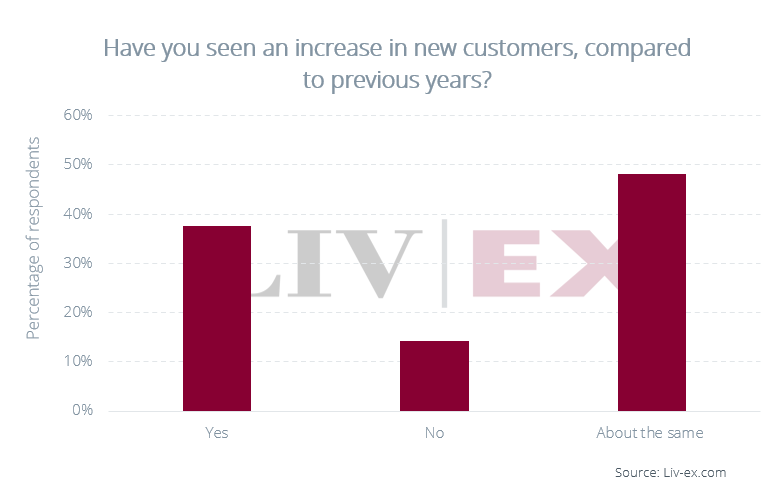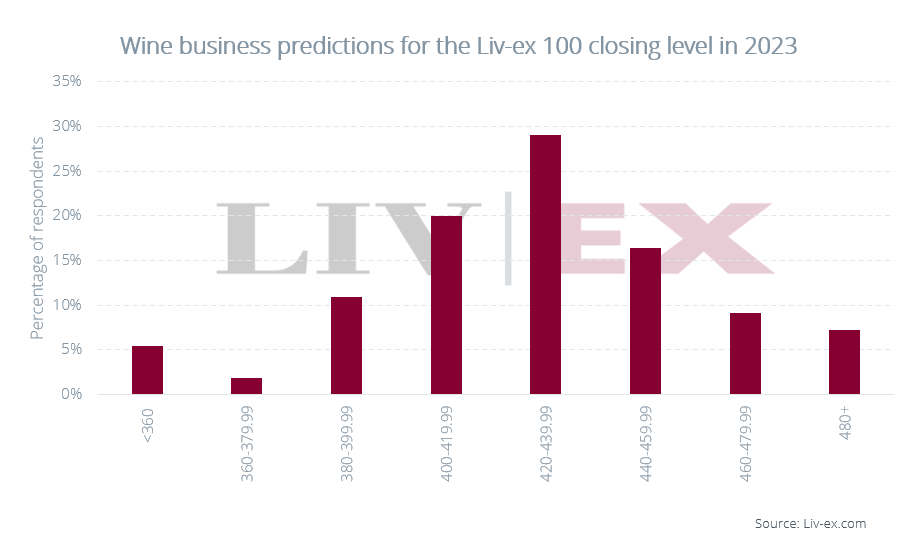Global wine trade predictions for 2023
Introduction
Liv-ex members represent the largest pool of professional fine wine traders in the world and are estimated to account for 90% of fine wine turnover globally. There are currently 625 members of Liv-ex across 44 countries that range from start-ups to centuries old, established merchants.
Each year, we ask our members for their thoughts and predictions on the year ahead in the form of a short survey.
The following report takes a closer look at what the global wine trade think lies ahead for 2023.
Overall trade outlook
The first question we asked members was ‘which of the following would best describe your outlook for the fine wine trade in 2023?’
The responses were mixed. 38% reported that they were ‘quite optimistic’, while 5% said they were ‘very optimistic’.
On the other hand, 21% said they were ‘quite pessimistic’ and 34% were neutral.

Market challenges
The next question asked ‘what will be the market’s biggest challenge in 2023?’ For this question, members were more aligned, with over half (54%) mentioning the global economy.
Global economy
Of those who referenced the economy, most (30%) noted a global economic downturn along with regional recessions. 20% cited currency volatility as a concern.
Other answers included inflation, declining risk appetite amongst investors and general market uncertainty.
Logistics and supply chain
The second biggest challenge the trade is expecting are logistic and supply chain issues, with 16% mentioning one or the other in their response.
Some respondents noted that additional paperwork due to planned UK duty changes and labelling as a headache, while others referenced ongoing disruption to Chinese imports.
China
China itself featured in 12% on respondents answers, with many noting their Covid-zero policy along with declining demand from Hong Kong as ongoing issues.
It is worth noting, however, that the survey was conducted before China abandoned key parts of its zero-Covid strategy in early December.
Stock shortages
Stock shortages accounted for 12% of answers, with many noting that there wasn’t enough stock to satisfy demand, particularly in reference to the release of Burgundy’s 2021 vintage.
Increasingly limited released volumes of vintage champagne were also mentioned.
Rising prices
Finally, 10% of respondents noted rising prices as the biggest challenge they face in 2023. One said that ‘some customers will reject […] pricing’ for upcoming ex-domaine and chateau releases. And as a result they ‘expect some deterioration of [their] client base.’
Another noted that finding customers interested in physical stock at such high market prices will be a challenge.
Other responses to this question included war (9%) and rising costs of doing business (5%).
Most in demand brands and regions
The next question asked ‘what has been the most in demand wine brand or region of 2022? Why?’
Regions
As the chart below shows, Burgundy was the winner here with 41.8% of respondents selecting it as the region most in demand.
Low yields and restrained releases coupled with high demand were cited as the reason for this. One noted that ‘all the investors are playing pass the parcel’ due to stock limitations.
Several referenced white Burgundy in particular, with one noting its ‘lack of supply and speculation’ as a reason for its increased demand.
Liv-ex members have access to over £80m of live trading opportunities on the global marketplace.
Not yet a member?
40% said that Champagne was the most in demand region, with the majority also noting decreasing supply and high demand for vintage champagnes.
Some said that Champagne was relatively good value compared to others, with strong investment growth. While others attributed the region’s success to the fact that ‘more people drink than speculate.’ Another respondent agreed that Champagne was ‘the most fun that you can have when drinking any wine.’
Bordeaux also remains a firm favourite with the trade. 9% said that it was the most in demand region, with many praising its strong vintages, reliable quality and value.
Other responses to this question included Tuscany (3.6%), California (3.6%) and interestingly whisky (1.8%). Earlier in 2022, we reported on the rising trade for Scotch whisky on Liv-ex.

Brands
The responses for the most in demand wine brands were mixed. One of the most agreed-upon brands was Domaine de la Romannee-Conti (7%), with one noting that it was ‘consistently the most sought after and requested’. Others noted that demand for the brand was coming from Asia and ‘crypto-boy speculators’ in particular.
Dom Perignon was also frequently mentioned (7%), with one London retailer noting that they sell Dom Perignon every day despite charging some of the most expensive prices in retail.
They continued, demand for the wine has ‘forced [them] to go to the secondary market looking for back vintage stock, which when offered at ambitious pricing also sells out instantly.’
Other key brands mentioned were Armand Rousseau and Domaine Leflaive.
All these wines placed in the top 10 in the 2022 Liv-ex Power 100 – our annual ranking of the most powerful wines brands.
Customer buying patterns
When asked ‘how have your customers’ buying patterns changed in 2022?’ the responses were extremely varied.
14.5% said that their customers’ buying patterns had not changed or remained the same.
However, 10% said that buyers had become more selective, while 7% said portfolios had become more diversified.
Several noted increases in Champagne (9%) and Californian (5%) buying. Increased purchases for Rhone and Tuscan wines were also mentioned.
Others noted that customers were spending more on average, but emphasised that this was due to customers focusing on quality over quantity. One merchant noted that their customers were ‘drinking fractionally less and much better.’
Many respondents also referenced challenges in Asia, while several noted that demand had dropped off in the second half of the year.
Some commented that more customers were doing their own trading online, rather than using brokers.
Our recent report on ‘The Wine Business of Tomorrow’ looks at three innovative models that wine businesses can use to facilitate customer broking and online purchasing through Liv-ex.
New Customers
The chart below shows how members responded to our fifth question on whether they had seen an increase in new customers in 2022.
48% said that their customer base had remained the same, while 37% reported an increase in new customers. 14% said that they hadn’t seen an increase.
When asked to provide details, those that saw an increase in new customers reported that they had expanded their private client sales teams. One noted that their increase came from Asia and Europe, while another specified that although they had seen new customers, there were still fewer than 2020 when covid led to a boom in sales.
Attract new customers by offering more wines without holding stock. Connect with Liv-ex via API.
Reasons varied among those that hadn’t seen an increase. One noted that the wine market was very saturated, while another said that they had seen a drop off in clients from Hong Kong, but new clients from Singapore and Taiwan.

Index Predictions
As part of the survey, we asked wine businesses to predict the closing level of the Liv-ex Fine Wine 100 index for December that year.
The Liv-ex Fine Wine 100 Index is the industry benchmark. It represents the price movement of 100 of the most sought-after fine wines on the secondary market.
Liv-ex members are expecting fine wine prices to rise in 2023, but only marginally. On average, respondents predicted that the index would increase by 1.6% to close at 428.79. The median response was slightly higher at 429.05, representing a 1.7% rise.
60% of those surveyed predicted that the index would rise, while 40% thought it would fall. The most optimistic respondent expects gains of 45%; the most pessimistic predicted a drop of 28%.

Big predictions for 2023
Our final question – ‘what is your other big prediction for the year ahead in the wine trade?’ There were lots of responses to this question providing a range of insights.
Burgundy price corrections
The most popular answer predicted some form of price correction for Burgundy, with 14% of respondents mentioning this. Most commented that this will focus on the most speculative brands like Arnoux-Lachaux because they believe prices are not sustainable in the long term.
That being said, many thought that Burgundy’s white wines would have a successful year.
Bordeaux resurgence
7% of respondents forecast a resurgence for Bordeaux and predicted that there would be increased demand for the region.
However, views on the region remained mixed. Equal amounts of respondents predicted that Bordeaux would have both a successful and a not so successful 2022 En Primeur campaign.
One noted that high release prices will kill the campaign and drive demand to older vintages.
Increased demand for other regions
This demand also extended to Piedmont, where several suggested that the region would go ‘crazy’ and that there would be increased interest for Barolo.
Increased demand for California was also mentioned. Others believed that champagne would continue to remain in favour and that grower champagnes would pick up pace.
Increasing Asian demand
Many noted that there would be increased interest in fine wine from other regions in Asia. Japan, Taiwan, Singapore and South Korea, in particular, were all mentioned.
Business struggles
Other responses were less optimistic, with many predicting bankruptcies and merchants going out of business.
Some expected to see mergers between larger UK merchants and the consolidation of some smaller companies was also on the horizon.
The changing role of technology
Many thought that technology would continue to grow in importance. While some believed that the industry was not ready for blockchain technology (and thus predicted its demise), most suggested that technology will continue to change the way wine is traded.
One respondent noted that ‘customers will demand more transparency, more liquidity, faster transaction time, more choice and wan
Let Liv-ex help you digitally transform your wine business to meet the demands of your customers.
Summary
This survey was conducted among Liv-ex members in November 2022. It provides a fascinating insight into what the global wine trade think might happen in 2023.
As always, Liv-ex will be watching and will continue to provide independent data, direct from the market as the year progresses.
Interested in Liv-ex membership?
Liv-ex is the global marketplace for the wine trade. Our members range from start-ups to established merchants and we supply them with the tools they need to price, source and sell wine more efficiently. For more information on how we can help you, click on the link that best describes you below:
Request a demo to see the exchange and a member of our team will be in touch with you shortly.
Liv-ex analysis is drawn from the world’s most comprehensive database of fine wine prices. The data reflects the real time activity of Liv-ex’s 600 merchant members from across the globe. Together they represent the largest pool of liquidity in the world – currently £80m of bids and offers across 16,000 wines.
